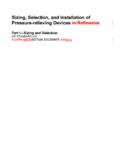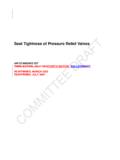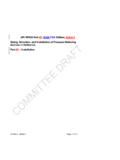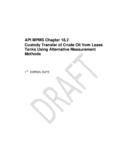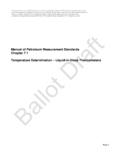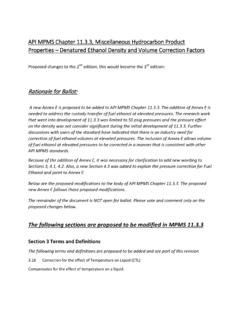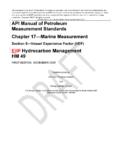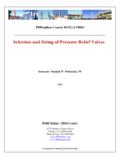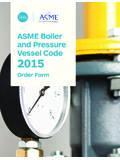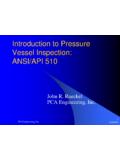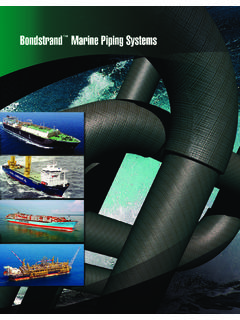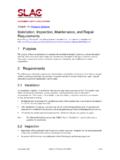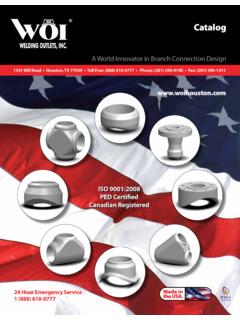Transcription of Guidelines for a Material Verification Program for …
1 API RP 578 3rd edition, re-written in new format. New proposed text is highlighted in yellow. st 1 version proposed for ballot 1-15-16 .. JLYoakam Editor Page 1 of 24. Guidelines for a Material Verification Program for New and Existing Assets 1. SCOPE. Purpose The purpose of this recommended practice (RP) is to provide the Guidelines for the owner-user to develop and implement a Material Verification Program (MVP) as part of a quality assurance Program . The MVP uses PMI and other methods to verify that the nominal composition of an asset, an asset component, or weldment within the pressure envelope is consistent with the selected or specified construction materials. to minimize the potential for catastrophic release of toxic or hazardous liquids or vapors. A well designed and implemented MVP is one of the most important tools used to minimize the potential for catastrophic release of toxic or hazardous liquids or vapors, and other general products contained.
2 About this Document This RP provides the Guidelines for Material Verification programs involving ferrous and non-ferrous alloys during the construction, installation, maintenance, and inspection of new and existing process equipment. This RP applies to metallic materials purchased for use either directly by the owner/user or indirectly through vendors, fabricators, or contractors and includes the supply, fabrication, and installation of these materials. Carbon steel components specified in new or existing piping systems are not specifically covered under the scope of this document unless minor/trace alloying elements are critical to component corrosion resistance or similar degradation. Material Verification programs in General Methods for managing materials are part of an overall Quality Assurance Program or Quality Management system. Purchasing agreements should include clearly stated requirements related to chemical composition (including allowed trace or tramp elements), mechanical properties, critical dimensions, and other acceptance criteria.
3 The personnel involved in Material manufacturing and related quality assurance process must be suitably trained and qualified. Personnel must also have clear requirements related to their duties and up to date acceptance thresholds. A clearly defined and documented process needs to be in place and understood by all personnel involved in the production, testing, and acceptance of Material . Periodic audits should be API RP 578 3rd edition, re-written in new format. New proposed text is highlighted in yellow. st 1 version proposed for ballot 1-15-16 .. JLYoakam Editor Page 2 of 24. conducted at all stages to ensure that processes are being followed: that the techniques used to validate the materials meet requirements, and that processes are delivering consistent results. When MVP techniques identify materials that do not meet requirements, it is imperative to follow existing quality processes, and correct root causes identified processes that led to the nonconforming product.
4 Using the above with a well thought out and documented MVP process, PMI is invaluable in the overall achievement of 100% Material assurance. 2. REFERENCES. Normative The following referenced documents are indispensable for the application of this document. For dated references, only the edition cited applies. For undated references, the latest edition of the referenced document (including any amendments) applies. API 510, Pressure Vessel Inspection Code: In-service Inspection, Rating, Repair, and Alteration API 570, Piping Inspection Code: Inspection, Repair, and Rerating of In-service Piping Systems API Recommended Practice 574, Inspection Practices for Piping System Components API Recommended Practice 575, Guidelines and Methods for Inspection of Existing Atmospheric and Low-pressure Storage Tanks API Recommended Practice 576, Inspection of Pressure-Relieving Devices API Recommended Practice 577, Welding Inspection and Metallurgy API Recommended Practice 751, Safe Operation of Hydrofluoric Acid Alkylation Units API RP 939-C, Guidelines for Avoiding Sulfidation Corrosion Failures in Oil Refineries Informative The following referenced documents are informative in the application of this document.
5 For dated references, only the edition cited applies. For undated references, the latest edition of the referenced document (including any amendments) applies. API RP 571, Damage Mechanisms Affecting Fixed Equipment In the Refining Industry API Recommended Practice 580, Risk-Based Inspection API 579-1/ASME FFS-1 Fitness-For-Service API RP 578 3rd edition, re-written in new format. New proposed text is highlighted in yellow. st 1 version proposed for ballot 1-15-16 .. JLYoakam Editor Page 3 of 24. ASME1 Boiler and Pressure Vessel Code: Section II. Part A: Material Specifications Part B: Ferrous Materials Part C: Nonferrous Materials Part D: Welding Rods, Electrodes, and Filler Metals ASME PCC-2, Repair of Pressure Equipment and Piping ASME , Process Piping CSB2 Chemical Safety Board Bulletin 2005-04-B, Positive Material Verification : Prevent Errors During Alloy Steel Systems Maintenance . NACE3 Paper No 03651, Specification for Carbon Steel Materials for Hydrofluoric Acid Alkylation Units.
6 PFI4 ES22, Recommended Practice for Color Coding of Piping Materials Footnotes ---------------------------------------- ---- 1. ASME International, 3 Park Avenue, New York, New York 10016-5990, 2. Chemical Safety and Hazard Investigation Board, Office of Prevention, Outreach, and Policy, 2175 K Street NW, Suite 400, Washington, 20037-1848, 202-261-7600, Most CSB publications are posted on, and can be downloaded from the CSB web site, 3. NACE International , 1440 South Creek Drive, Houston, Texas 77218-8340, 4. Pipe Fabrication Institute, 511 Avenue of the Americas, #601, New York, New York 10011. DEFINITIONS AND ACRONYMS. Definitions Alloy Material - Any metallic Material (including welding filler materials) that contains alloying elements, such as chromium, nickel, or molybdenum, which are intentionally added to enhance mechanical or physical properties and/or corrosion resistance. Alloys may be ferrous or non-ferrous based. Distributor - A warehousing supplier for manufacturers or suppliers of materials or components.
7 Fabricator - One who fabricates piping systems, or portions of a piping system, as defined by ASME Heat - A batch of metal made at the same time, able to be traced from its original constituents and manufacturing process API RP 578 3rd edition, re-written in new format. New proposed text is highlighted in yellow. st 1 version proposed for ballot 1-15-16 .. JLYoakam Editor Page 4 of 24. Inspection Lot - A group of items or materials of the same type from a common source from which a sample is to be drawn for examination. NOTE: An inspection lot shall not include items from more than one heat. Level of examination - The specified percentage of the number of items to be examined in an inspection lot. Lot size - The number of items available in the inspection lot at the time a representative sample is selected. Material manufacturer - An organization that performs or supervises and directly controls one or more of the operations that affect the chemical composition or mechanical properties of a metallic Material .
8 Material nonconformance - A positive Material identification (PMI) test result that is not consistent with the specified Material . Material supplier - An organization that supplies Material furnished and certified by a Material manufacturer, but does not perform any operation intended to alter the Material properties required by the applicable Material specification. Material Verification Program - A documented quality assurance procedure used to assess materials (which can include weldments and attachments when specified) in order to verify conformance to a specification as designated by the owner/user. The Program should include a description of methods for Material testing, component marking, and record-keeping. Mill Test Report (MTR) - A document issued and certified by the Material manufacturer identifying an item according to its heat and confirming conformance to specification. Mill test reports include the results of specification-required testing including the original chemical analysis.
9 Owner-user - The organization that exercises control over the operation, engineering, inspection, repair, alteration, pressure testing, and rating of the piping systems. Pressure-containing components - Items that form the pressure-containing envelope of the piping system. Positive Material Identification (PMI) - A physical evaluation or test of a Material performed to confirm that the Material which has been or will be placed into service is consistent with what is specified by the owner/user. These evaluations or tests may provide either qualitative or quantitative information that is sufficient to verify the composition. Random - Selection process by which choices are made in an arbitrary and unbiased manner. Representative sample - One or more items selected at random from the inspection lot that are to be examined to determine acceptability of the inspection lot. API RP 578 3rd edition, re-written in new format. New proposed text is highlighted in yellow.
10 St 1 version proposed for ballot 1-15-16 .. JLYoakam Editor Page 5 of 24. Standard reference materials - Sample materials for which laboratory chemical analysis data are available and are used in demonstrating the accuracy and reliability of a test instrument. Acronyms API American Petroleum Institute ASME American Society of Mechanical Engineers IDL Instrument Detection Limit LOD Limit of Detection LOQ Limit of Quantization MDL Method Detection Limit MTR Mill Test Report MVP Material Verification Program NACE National Association of Corrosion Engineers PFI Pipe Fabrication Institute PMI Positive Material Identification RSD Relative Standard Deviation SD Standard Deviation API RP 578 3rd edition, re-written in new format. New proposed text is highlighted in yellow. st 1 version proposed for ballot 1-15-16 .. JLYoakam Editor Page 6 of 24. APPLICABILITY CONSIDERATIONS AND GENERAL CONCERNS. Applicability <A paragraph suggesting applicability key points in upstream, midstream and downstream sectors is required>.
